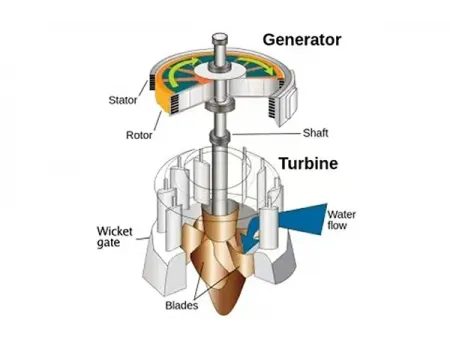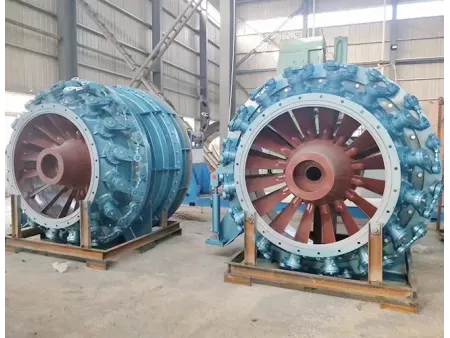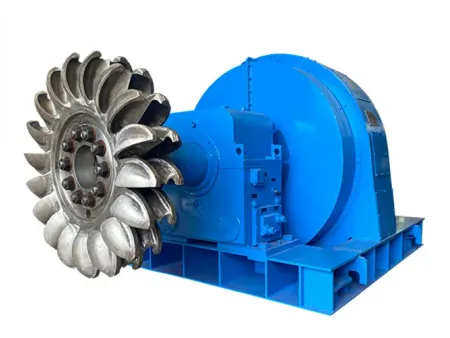Hydropower Turbines
A hydro turbine-generator unit is a power generation system that produces electricity by converting the kinetic energy of flowing water into mechanical energy through a water turbine, which in turn drives the rotor of a hydro generator.
In a hydropower station, water is concentrated by a dam and directed through a pressurized penstock to the turbine. The force of the water causes the turbine to rotate, and this mechanical motion drives the connected generator, producing electrical energy.
Using the natural energy of flowing water, hydropower turbines offer a reliable and sustainable solution for industrial challenges. Designed for optimal efficiency and durability, water turbines ensure a consistent, eco-friendly energy supply. By reducing dependence on fossil fuels, hydropower turbines significantly cut greenhouse gas emissions. Additionally, water turbines do not depend on fuel price volatility, offering financial stability in energy costs over time.
Choosing hydropower turbines, you invest in innovative technology that supports a cleaner environment, stronger industries, and smarter water management. What types of water turbines do you offer?
Our company supplies turbines classified by their operating principles into impulse turbines and reaction turbines. Impulse turbines generate rotational motion by the impact of water jets on the turbine runner, while reaction turbines are driven by the reactive force produced as water flows over the blades.
Our reaction turbine stock includes:
- Mixed-flow (Francis) turbines
- Axial-flow (Kaplan) turbines
- Tubular (propeller) turbines.
What are the types of tubular turbines?
The tubular turbine is a perfect choice for very low head and very high flow rates, offering large flow capacity, high specific efficiency, and the advantage of requiring no excavation.
Structurally, tubular turbines can be classified into:
- Spherical
- Pit-type
- Siphon-type
- “S” type
What type of turbine is a Pelton wheel turbine?
A Pelton wheel turbine is a type of impulse turbine, in which the water jet flows tangentially onto the runner buckets. The water in a Pelton turbine has a high velocity, and the turbine extracts energy by reducing the water jet velocity through impulse action.
Which water turbine should be used for high head and low flow rate?
Impulse turbines are primarily employed for high water head and low flow rate conditions.
What is the operating principle of a water turbine?
In a turbine, the blades or buckets are strategically positioned to redirect the water flow, thereby altering its momentum. The change in water momentum generates a corresponding force that causes the rotor or turbine runner to rotate. A key factor in this process is the magnitude of the momentum change, as it directly affects the applied force. The greater the momentum change, the higher the force exerted, which enhances the energy conversion efficiency.
What are the industries where water turbines can be applied?
- Power generation: Water turbines are extensively employed in hydropower plants to convert the energy of flowing or falling water into electricity, providing a reliable and renewable energy source
- Industrial processes: Water supply mechanical power for various industrial applications such as milling, pumping, and driving machinery, enhancing operational efficiency and productivity
- Water supply and irrigation: Water turbines drive pumps in water supply systems and irrigation networks, facilitating the effective distribution of water for domestic and agricultural use
- Flood control and water resource management: Regulating the flow of rivers and reservoirs, hydraulic turbines play a crucial role in flood prevention and the management of water resources.




